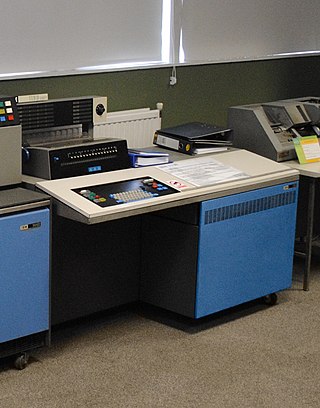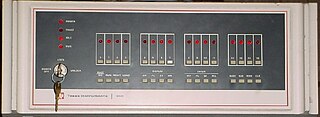In computer science, threaded code is a programming technique where the code has a form that essentially consists entirely of calls to subroutines. It is often used in compilers, which may generate code in that form or be implemented in that form themselves. The code may be processed by an interpreter or it may simply be a sequence of machine code call instructions.
x86 assembly language is the name for the family of assembly languages which provide some level of backward compatibility with CPUs back to the Intel 8008 microprocessor, which was launched in April 1972. It is used to produce object code for the x86 class of processors.
In computer programming, a parameter or a formal argument is a special kind of variable used in a subroutine to refer to one of the pieces of data provided as input to the subroutine. These pieces of data are the values of the arguments with which the subroutine is going to be called/invoked. An ordered list of parameters is usually included in the definition of a subroutine, so that, each time the subroutine is called, its arguments for that call are evaluated, and the resulting values can be assigned to the corresponding parameters.
In compiler construction, strength reduction is a compiler optimization where expensive operations are replaced with equivalent but less expensive operations. The classic example of strength reduction converts strong multiplications inside a loop into weaker additions – something that frequently occurs in array addressing.(Cooper, Simpson & Vick 1995, p. 1)

The IBM 1130 Computing System, introduced in 1965, was IBM's least expensive computer at that time. A binary 16-bit machine, it was marketed to price-sensitive, computing-intensive technical markets, like education and engineering, succeeding the decimal IBM 1620 in that market segment. Typical installations included a 1 megabyte disk drive that stored the operating system, compilers and object programs, with program source generated and maintained on punched cards. Fortran was the most common programming language used, but several others, including APL, were available.
In computer programming, a thunk is a subroutine used to inject a calculation into another subroutine. Thunks are primarily used to delay a calculation until its result is needed, or to insert operations at the beginning or end of the other subroutine. They have many other applications in compiler code generation and modular programming.
In computer programming, a return statement causes execution to leave the current subroutine and resume at the point in the code immediately after the instruction which called the subroutine, known as its return address. The return address is saved by the calling routine, today usually on the process's call stack or in a register. Return statements in many programming languages allow a function to specify a return value to be passed back to the code that called the function.
IEFBR14 is an IBM mainframe utility program. It runs in all IBM mainframe environments derived from OS/360, including z/OS. It is a placeholder that returns the exit status zero, similar to the true command on UNIX-like systems.
Loop unrolling, also known as loop unwinding, is a loop transformation technique that attempts to optimize a program's execution speed at the expense of its binary size, which is an approach known as space–time tradeoff. The transformation can be undertaken manually by the programmer or by an optimizing compiler. On modern processors, loop unrolling is often counterproductive, as the increased code size can cause more cache misses; cf. Duff's device.
In computer science, a tail call is a subroutine call performed as the final action of a procedure. If the target of a tail is the same subroutine, the subroutine is said to be tail recursive, which is a special case of direct recursion. Tail recursion is particularly useful, and is often easy to optimize in implementations.
In computer science, a call stack is a stack data structure that stores information about the active subroutines of a computer program. This type of stack is also known as an execution stack, program stack, control stack, run-time stack, or machine stack, and is often shortened to simply "the stack". Although maintenance of the call stack is important for the proper functioning of most software, the details are normally hidden and automatic in high-level programming languages. Many computer instruction sets provide special instructions for manipulating stacks.
In computer science, a calling convention is an implementation-level (low-level) scheme for how subroutines or functions receive parameters from their caller and how they return a result. When some code calls a function, design choices have been taken for where and how parameters are passed to that function, and where and how results are returned from that function, with these transfers typically done via certain registers or within a stack frame on the call stack. There are design choices for how the tasks of preparing for a function call and restoring the environment after the function has completed are divided between the caller and the callee. Some calling convention specifies the way every function should get called. The correct calling convention should be used for every function call, to allow the correct and reliable execution of the whole program using these functions.
An instruction set simulator (ISS) is a simulation model, usually coded in a high-level programming language, which mimics the behavior of a mainframe or microprocessor by "reading" instructions and maintaining internal variables which represent the processor's registers.
Galaksija BASIC was the BASIC interpreter of the Galaksija build-it-yourself home computer from Yugoslavia. While being partially based on code taken from TRS-80 Level 1 BASIC, which the creator believed to have been a Microsoft BASIC, the extensive modifications of Galaksija BASIC—such as to include rudimentary array support, video generation code and generally improvements to the programming language—is said to have left not much more than flow-control and floating point code remaining from the original.
The IBM Basic assembly language and successors is a series of assembly languages and assemblers made for the IBM System/360 mainframe system and its successors through the IBM Z.
This article describes the calling conventions used when programming x86 architecture microprocessors.

The TI-990 was a series of 16-bit minicomputers sold by Texas Instruments (TI) in the 1970s and 1980s. The TI-990 was a replacement for TI's earlier minicomputer systems, the TI-960 and the TI-980. It had several unique features, and was easier to program than its predecessors.

Control tables are tables that control the control flow or play a major part in program control. There are no rigid rules about the structure or content of a control table—its qualifying attribute is its ability to direct control flow in some way through "execution" by a processor or interpreter. The design of such tables is sometimes referred to as table-driven design. In some cases, control tables can be specific implementations of finite-state-machine-based automata-based programming. If there are several hierarchical levels of control table they may behave in a manner equivalent to UML state machines
The structure of the Perl programming language encompasses both the syntactical rules of the language and the general ways in which programs are organized. Perl's design philosophy is expressed in the commonly cited motto "there's more than one way to do it". As a multi-paradigm, dynamically typed language, Perl allows a great degree of flexibility in program design. Perl also encourages modularization; this has been attributed to the component-based design structure of its Unix roots, and is responsible for the size of the CPAN archive, a community-maintained repository of more than 100,000 modules.
In computer programming, a function is a callable unit of software logic that has a well-defined interface and behavior and can be invoked multiple times.


